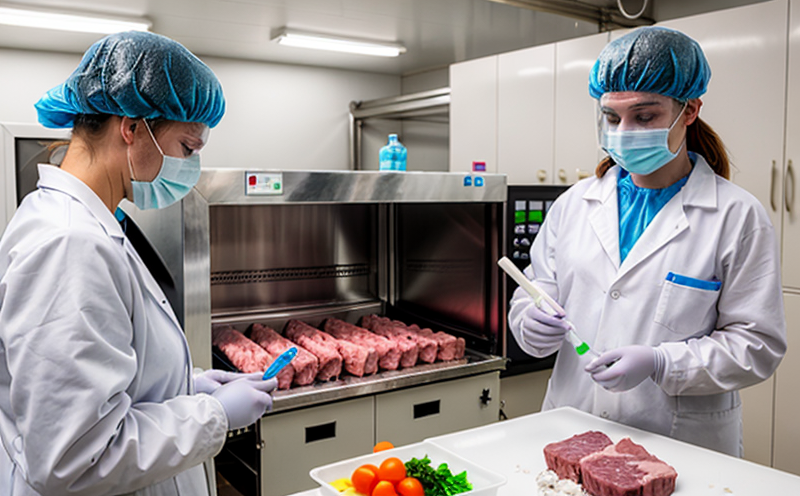USDA FSIS Salmonella Performance Standard Testing in Meat
The USDA Food Safety and Inspection Service (FSIS) sets performance standards for the meat industry to ensure public health. One of these standards is the Salmonella Performance Standard, which requires establishments producing raw ground beef products to achieve a specified level of Salmonella contamination in their products.
The primary goal of this testing is to safeguard consumer health by reducing the risk of foodborne illness. According to FSIS regulations (9 CFR 417), an establishment must meet or exceed a performance standard for Salmonella. Failure to comply can lead to sanctions, including product recalls and potential closure.
This testing is conducted at various stages in the meat production process, focusing on raw ground beef products. The standard aims to reduce the prevalence of Salmonella to a level that minimizes public health risks while allowing for practical control measures within the industry.
The testing methodology involves sampling and analyzing raw ground beef products using microbiological culture techniques. Laboratories adhere to strict protocols defined by FSIS, ensuring accurate and reliable results. The performance standard is based on the Salmonella prevalence in 100 grams of raw ground beef as determined by a series of samples.
The testing process begins with specimen preparation, where raw ground beef samples are collected from various points along the production line. These samples undergo rigorous microbiological analysis to identify and quantify Salmonella contamination levels.
To meet FSIS standards, laboratories must use advanced instrumentation and techniques such as:
- Culture media for selective isolation of Salmonella
- Polymerase Chain Reaction (PCR) for rapid detection
- Flow cytometry for precise quantification
The results are reported according to FSIS guidelines, providing a clear indication of the establishment's compliance with the performance standard. Laboratories must ensure that their testing procedures align with these standards and maintain accurate records.
In summary, USDA FSIS Salmonella Performance Standard Testing in Meat is critical for maintaining public health and ensuring food safety. It provides a standardized approach to monitoring Salmonella contamination in raw ground beef products, enabling meat establishments to meet regulatory requirements and protect consumers from potential foodborne illnesses.
Why It Matters
The USDA FSIS Salmonella Performance Standard Testing in Meat is crucial for several reasons:
- Promotes Public Health: By reducing Salmonella contamination, this testing helps prevent foodborne illnesses and associated health risks.
- Ensures Regulatory Compliance: Establishments must adhere to FSIS standards to avoid penalties such as product recalls and closures.
- Enhances Consumer Confidence: Consumers trust in the safety of meat products is bolstered by rigorous testing protocols.
- Safeguards Business Reputation: Compliance with these standards protects the reputation and integrity of food producers.
The implications are far-reaching, affecting not only the tested establishments but also the broader industry. By adhering to these standards, meat producers can ensure that their products meet or exceed regulatory requirements, thereby safeguarding public health and maintaining consumer trust.
Furthermore, this testing contributes to a safer food supply chain by identifying and mitigating potential sources of contamination early in the production process. It also facilitates continuous improvement in hygiene practices and quality control measures within meat processing facilities.
Industry Applications
| Application | Description |
|---|---|
| Raw Ground Beef Production: | Testing is conducted on raw ground beef products to ensure compliance with FSIS performance standards. |
| Quality Control: | Laboratories monitor the quality of raw meat products by ensuring they meet specified Salmonella contamination levels. |
| Product Recall Prevention: | Testing helps prevent recalls and potential health risks associated with high Salmonella contamination in raw ground beef. |
| Regulatory Compliance: | Establishments comply with FSIS regulations to avoid penalties and maintain a good reputation. |
The testing is particularly relevant for establishments that produce raw ground beef products. By ensuring compliance with the USDA FSIS Salmonella Performance Standard, these establishments can safeguard public health and meet regulatory requirements.
- Raw Ground Beef: Testing on this product ensures compliance with strict Salmonella performance standards set by FSIS.
- Quality Control: Laboratories monitor the quality of raw meat products, ensuring they meet specified contamination levels.
- Product Recall Prevention: By identifying high Salmonella contamination early in the production process, recalls can be prevented and health risks mitigated.
- Regulatory Compliance: Establishments comply with FSIS regulations to avoid penalties and maintain a good reputation.
The testing is essential for maintaining public health and ensuring food safety. By adhering to these standards, meat producers can safeguard their business reputation and protect consumers from potential health risks associated with high Salmonella contamination in raw ground beef products.
Customer Impact and Satisfaction
The USDA FSIS Salmonella Performance Standard Testing in Meat has a direct impact on customer satisfaction by ensuring the safety of meat products. By reducing Salmonella contamination, this testing helps prevent foodborne illnesses and associated health risks. This, in turn, enhances consumer confidence in the quality and safety of meat products.
Customers benefit from:
- Safe and reliable meat products that meet or exceed FSIS performance standards.
- A reduction in the risk of foodborne illnesses associated with high Salmonella contamination.
- Improved trust in the quality and safety of meat products, leading to increased customer satisfaction.
Establishments that comply with these testing protocols demonstrate a commitment to public health and consumer safety. This dedication fosters strong relationships with customers and enhances overall business reputation.
In addition to safeguarding public health, this testing also contributes to the sustainability of meat production by identifying and mitigating potential sources of contamination early in the process. This proactive approach ensures that products meet or exceed regulatory requirements, thereby protecting both consumers and producers from potential risks.





